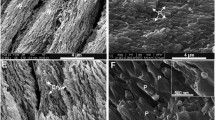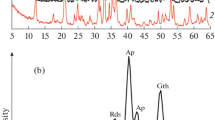Abstract
The purpose of the present work was to investigate the infrared (IR) spectrum of shark enameloid, especially with regard to hydroxide and carbonate bands. With thin sections placed directly in the IR beam it was possible to get high concentrations of ions without interfering effects from a dispersion medium (e.g., alkali halides). For comparison, spectra of shark dentin and a geo-apatite were also recorded. In spectra of shark enameloid and geo-apatite medium strong hydroxide absorption bands were found around 3535 cm−1, and in shark dentin and geo-apatite spectra weak shoulders were observed at about 3570 cm−1. Hydroxide libration bands at about 740 cm−1 were found in shark enameloid and geo-apatite spectra; in the latter, also a band at 680 cm−1. Carbonate bands were found in shark enameloid spectra at 1480 (weak shoulder), 1453, 1423, and 868 cm−1. In shark dentin spectra there were carbonate bands at 1452, 1417, and 875 cm−1, and probably also a carbonate band at about 1530 cm−1 overlapped by an amide II band. Weak carbonate bands were also found in the spectra of the geo-apatite at 1452 cm−1, and at about 1425 and 880 cm−1. The relative intensities of the bands at 1453 cm−1 (contributed from A and B sites) and around 1420 cm−1 (B sites) changed from shark enameloid to shark dentin, and also from shark enameloid to the geo-apatite. More A sites seem to be occupied by carbonate in shark dentin than in shark enameloid, supposedly owing to fluoride occupation of A sites in shark enameloid. In geo-apatite and shark enameloid there are hydroxide ions hydrogen bonded to fluoride. Both shark enameloid and the geo-apatite are fluoride rich, and geo-apatite seems to have the highest fluoride concentration. There are, however, indications that the hydroxide concentration is also higher in the geo-apatite than in shark enameloid. This can be explained by the much higher carbonate content, and partly also by the higher water content in shark enameloid. There are A sites in geo-apatite and probably also in shark enameloid which are occupied by carbonate, but the proportion of occupied A sites relative to occupied B sites is greater in geo-apatite than in shark enameloid. This difference can be explained by the preference of A sites when the carbonate concentration is very low. On the other hand, for greater amounts of carbonate such as we have in shark enameloid, B sites are preferred.
Similar content being viewed by others
Author information
Authors and Affiliations
Additional information
Received: 1 June 1998 / Accepted: 12 March 1999
Rights and permissions
About this article
Cite this article
Dahm, S., Risnes, S. A Comparative Infrared Spectroscopic Study of Hydroxide and Carbonate Absorption Bands in Spectra of Shark Enameloid, Shark Dentin, and a Geological Apatite. Calcif Tissue Int 65, 459–465 (1999). https://doi.org/10.1007/s002239900733
Published:
Issue Date:
DOI: https://doi.org/10.1007/s002239900733




